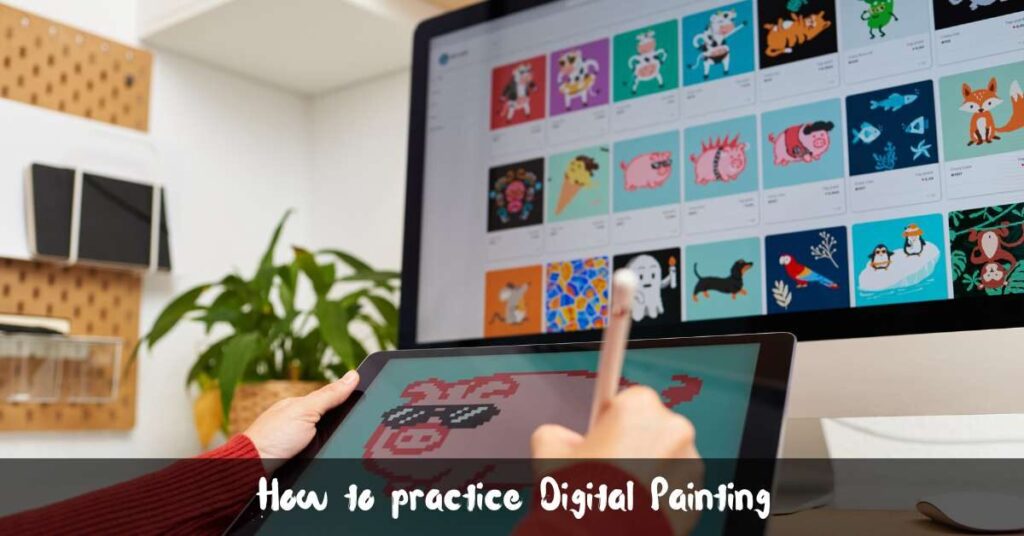What is Digital Painting?
Digital painting is an artistic technique where traditional painting methods like oil, watercolor, or acrylic are applied using digital tools such as a stylus, graphics tablet, and painting software. Imagine swapping your canvas and brushes for a tablet and stylus — that’s essentially the transformation digital painting brings. Instead of getting paint on your hands, you’re working with pixels and layers, bringing characters, landscapes, and abstract concepts to life with the stroke of a digital pen.
One of the beauties of digital painting is the flexibility it offers. You can easily undo mistakes, experiment with color palettes, and even mimic traditional textures like charcoal or watercolor with precision. Artists no longer need a studio filled with supplies — all you need is the right gear and creativity.
Digital painting is used widely in concept art, character design, gaming, comic creation, and advertising. Whether you’re sketching a whimsical creature or designing a futuristic world, the digital medium gives you the tools to bring your vision to life in a more efficient, modern way.
Why Learn Digital Painting Online?
Learning digital painting online has exploded in popularity, and for good reason. First off, it’s flexible. You don’t need to commute or adhere to strict schedules. Online courses allow you to learn at your own pace, revisit lessons anytime, and fit creative growth into your busy life.
Another massive perk? Accessibility to global talent. You can learn from top-tier industry professionals who’ve worked with major studios like Pixar or Blizzard, something that would be nearly impossible in a local setting. Whether you’re just starting or looking to refine your skills, online platforms offer a variety of courses tailored to every experience level.
Cost is also a big factor. Many high-quality online digital painting courses are significantly cheaper than traditional art school tuition. Plus, they often include lifetime access, updates, and community forums for ongoing support and networking.
When paired with the right equipment and mindset, online learning can be just as effective — if not more so — than traditional classroom methods. It democratizes art education, making it accessible for aspiring artists worldwide.
Key Features to Look for in a Digital Painting Course
Skill Level Suitability
The best digital painting courses cater to specific experience levels. A beginner should look for foundational courses covering basic concepts like brushwork, color theory, and software tools. Meanwhile, an intermediate or advanced artist might want classes focused on anatomy, lighting, composition, or portfolio development.
Always check the course description to ensure it matches your current level. A course that’s too advanced might overwhelm you, while one that’s too basic could bore you. Great courses often list their prerequisites and outline who it’s best suited for, making selection easier.
Course Curriculum Depth
Not all digital painting courses are created equal. Look for comprehensive curriculums that go beyond just techniques. A well-rounded course should cover:
-
Understanding color theory and lighting
-
Composition and perspective
-
Stylization and realism
-
Character and environment design
-
Using layers and masks effectively
-
Finalizing and exporting art
Courses that include case studies, real-time demonstrations, and assignments are golden. They provide hands-on experience and practical applications, which is essential in building confidence and mastery.
Interactive Components and Feedback
One key element of effective learning is feedback. Courses with peer reviews, instructor critiques, and community discussions help you see your blind spots and grow faster.
Live Q&A sessions, private forums, and downloadable resources add more value. Interactivity keeps you engaged and accountable. When a course includes mentorship or direct feedback, you’re more likely to improve because someone is guiding your progression, not just dumping information on you.
Tools and Software Training
Let’s face it — digital painting software can be overwhelming at first. Good courses introduce you to the tools gradually, making it easy to pick up even if you’re new to tech. Courses should ideally include training on popular programs like:
-
Adobe Photoshop
-
Corel Painter
-
Procreate
-
Krita
-
Clip Studio Paint
A course that walks you through customizing your brushes, using layers effectively, and optimizing your workflow will give you a solid technical foundation. Without these skills, even the best art concepts can fall flat.


